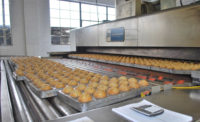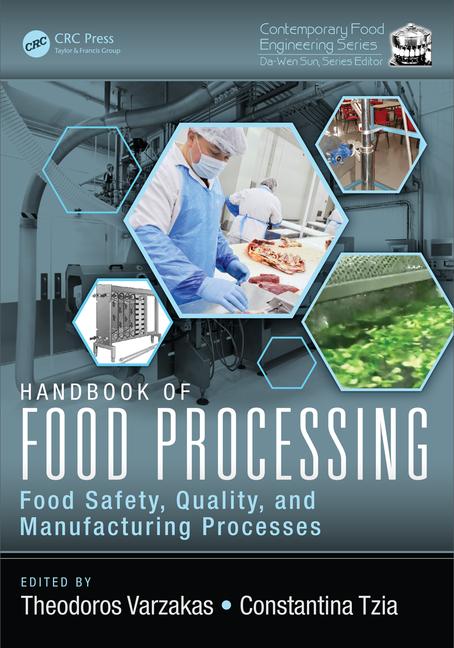Snack and bakery facilities have many concerns when it comes to their production areas and warehouses, and food safety is at the top of the list. From Salmonella to sanitary design, companies want to make sure they know what’s going on in their buildings, and that they keep on top of all necessary concerns and developments.
Top concerns
“The top food safety concern is a recall, such as the recent cereal recall for Salmonella. In snack and bakery facilities, sanitation has risen to the top of the list for food safety,” says John Kadinger, market manager, Key Technology, Walla Walla, WA.
After the thermal step that kills bacteria, equipment needs to get product into packages without contaminating it, Kadinger explains. “This means the equipment is easy to clean and that it stays clean during the production cycle.”
Kadinger also says that another top food safety concern is foreign material. “It’s crucial to find and remove foreign material.” This could include glass or rocks that arrive with raw materials, or objects like earplugs and pieces of metal or plastic inadvertently introduced by operators or equipment during processing. “Food manufacturers rely on a variety of inspection systems, including metal detector, X-ray systems and digital sorters at receiving, at packaging and points in between, to help deliver the product quality that consumers expect.”
Another top concern is controlling allergens, says Daniel Woo, quality assurance, regional manager, AIB International, Manhattan, KS. “Compliance with the FDA Preventive Controls Rule for Human Food (21 CFR Subpart 117) has been the top food safety concern for many facilities. Allergen cross-contact is mentioned more than 20 times in the Preventive Controls Rule.” In 2017 alone, he notes, there were 218 recalls attributed to undeclared allergens in food products.
An additional top concern is finding a common approach for speeding up food recalls, says Angela Fernandez, vice president of retail grocery and foodservice, GS1 US, Ewing, NJ. “Food traceability is a very important part of keeping snack foods and bakery items safe for consumption, simply because they often contain many different kinds of ingredients that comes from multiple sources. For example, if whey powder, a common ingredient in crackers, tests positive for Salmonella, that supplier must have an effective means to track all of the partners they supplied product to, and when.”
Fernandez notes that to make food recalls faster and more accurate, CPG companies and their supplier and retailer partners have been adopting food traceability procedures based on GS1 standards. “They uniquely identify ingredients in the supply chain, as well as their locations, so that all trading partner systems can communicate in a consistent, uniform manner.” This can greatly reduce the amount of time it takes to conduct a recall.
“Many ready-to-eat manufacturers are also going to great lengths to ensure foreign objects don’t contaminate their product,” says Gerry Gomolka, project developer, process improvements, Stellar, Jacksonville, FL. He recently worked with a client that requested thorough metal detection at various points throughout processing. The company’s metal detectors examined dough balls just after they were formed, after they were panned and when they came out of the spiral chiller.
Kevin Wilson, senior project engineer, Stellar, says that a lot of food safety standards from the meat industry have been transferring to the baking industry. “Many of our clients have recently requested boot scrubbers in their bakery facilities. Once a rarity in a bakery setting, boot scrubbers are now becoming more common, along with sanitizing stations at each entry point onto the production floor.”
Wilson also says that many of Stellar’s bakery clients want to meet new food safety standards, such as SQF Level 2 and beyond. “Buyers and distributors are requesting higher food safety standards from these plants, and they want to see the documentation to prove it.”
Design improvements
“The baking and snack manufacturing industry has made major strides in improving sanitary design at their facilities in recent years,” says Woo. Adoption of hygienic zoning has been an important aspect of sanitary design. Hygienic zoning aims to limit cross-contamination by dividing a facility into defined zones based on risk assessment. Higher-risk locations, such as areas handling ready-to-eat food products exposed to the environment, or transition points between raw and post-bake production areas, have been a special focus for hygienic zoning.
“In terms of structural considerations, seamless epoxy flooring that can better withstand daily operation and sanitation activities has been a noteworthy trend,” says Woo. “Also, pest exclusion is one of the top five cited violations in FDA inspections conducted from October 2016 to September 2017. Finally, the removal of paint on overhead structures in production areas has been gradually taking place to prevent flaking materials from contaminating food products.”
Fernandez says that food traceability has come a long way in recent years, but the recent romaine lettuce outbreak was a reminder that there is still a lot of work to be done. “Many suppliers have updated their business systems and modernized supply chain processes to specifically avoid repeating the long and dangerous food recalls of the early 2000s. Costly recalls that plagued the spinach, tomato and peanut categories had lasting effects for years, and even led to mistaken consumer distrust. Traceability programs can ensure these mysteries don’t happen again.”
Kadinger says that food processors and their equipment suppliers are paying more attention to sanitation, thanks to the FSMA. To achieve the highest sanitary standards, which is especially important after a kill step, he suggests installing enhanced conveyors that feature ground and polished welds within the product contract zones.
Wilson says many companies are changing equipment specifications to prevent bacterial contamination. “They’re not just using tube-frame style equipment/conveyor supports anymore. They’re moving toward open-frame equipment/conveyor supports to eliminate cavities that can foster bacterial growth or harborage of insects or rodents.”
Traceability upgrades
“Companies are improving traceability to help speed their response to quality problems, limit their exposure to product recalls and protect their brand integrity,” says Kadinger.
Key Technology offers its FMAlert feature, which is available as an option on many of its digital sorters. It allows the sorter to capture and save a time-stamped digital image of every object identified as foreign material. It also enables the sorter to send a signal to downstream equipment to ensure the foreign material is removed.
Many companies have switched over to electronic inventory management software systems that promote traceability from raw ingredients all the way to the finished product, says Woo. “These systems help facility personnel get real-time information on the utilization and location of food products using barcodes, handheld devices and electronic scaling terminals.”
FDA has updated its standards for lot tracking at bakery facilities, and many facilities are using computerized algorithms to help monitor processing, says Gomolka. “The ability to accurately trace products back to a more-precise point in time in which they were manufactured is extremely valuable. In the event of a recall, the benefits of this traceability are two-fold: It informs the consumer if their product is affected, and it helps the manufacturer better isolate the recall. Instead of having to recall a month’s worth of product, the manufacturer can now narrow it down to only two weeks’ worth of product, for example.”
“Manufacturers want to avoid being the next major food safety recall headline, so they’re motivated to step up their game when it comes to food safety practices,” says Wilson.











